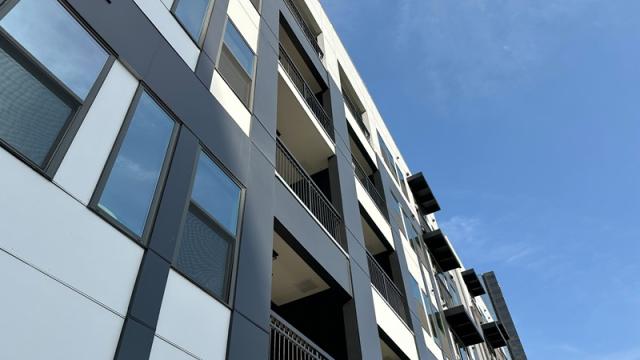
As members of Generation Z increasingly complete milestones like moving out on their own, it’s worth taking a closer at this next generation of renters. What are the youngest renters looking for in their rental search, and how do they differ from the millennials, Gen Xers, and Baby Boomers before them?
Let’s dive into what a recent renter survey from Apartments.com reveals about the youngest renters.
3 key traits of younger renters

Born between 1997 and 2012, Gen Z roughly maps onto the youngest cohort of renters ranging from their late teens to mid-20s. The Apartments.com survey, which included nearly 5,000 participants aged 18 to 24, reveals three significant trends that differentiate this group from the renter population overall.
Younger renters are overwhelmingly female
It’s no surprise to multifamily professionals that women are typically overrepresented among renters. Not only are women more likely to rent rather than own, they’re also more likely to be responsible for the rental search when living with a male partner.
But for the youngest renters (ages 18 to 24), this skew is even more dramatic, with nearly three times more women than men, or 74 percent overall. Among renters ages 35 to 44, in contrast, women make up only 63 percent of the renting population.
They don’t work remotely
Of all ages, the youngest renters are the most likely to be students (22 percent) or unemployed (7 percent).
But among those who work, they’re the age group most likely to be regularly working on site, rather than in hybrid or fully remote positions. Nearly 80 percent of employed 18- to 24-year-olds work exclusively in person.
Interestingly, the next age group, renters ages 25 to 34, are the least likely to have fully in-person jobs (only 61 percent), suggesting that young adults prefer to have remote or hybrid positions but may not be able to secure these roles early in their careers.
They’re likely to live with others
Renters ages 18 to 24 are the least likely to live alone and without pets (only 16 percent do so). They’re over twice as likely as the average renter to live with housemates or roommates, and 28 percent of them live with a partner or spouse. This number rises to 36 percent among renters ages 25 to 34.
Strong preference for online search tools

When renters in their 20s and early 30s look for an apartment, what tools do they use? Preferences for resources like internet listing sites and community websites reflected trends overall but were more heavily skewed towards online options:
- Rental search apps and websites are used by 74 percent of renters ages 18 to 24 and 78 percent of renters ages 25 to 34
- Younger renters are more likely to report using a search engine to find a rental (49 percent of renters ages 18 to 24 and 52 percent of renters 25 to 34)
- Over a quarter use social media in their search (27 percent of 18- to 24-year-olds and 28 percent of 25- to 34-year-olds)
Consistent with growing up in a digital age, the youngest renters are the most likely of all renters to consider ratings and reviews to be an important factor in their rental search. In fact, 99 percent of 18- to 24-year-olds say ratings and reviews are important, three percentage points higher than renters ages 45 and up.
Proximity to work or school matters

Still, some old-fashioned strategies haven’t disappeared. About a third of young renters report walking or driving around neighborhoods in their rental search (32 percent of renters ages 18 to 24 and 34 percent of those ages 25 to 34).
This makes sense, when you consider that proximity to work or school is more important for this age group than for other renters. A whopping 41 percent of renters ages 18 to 24 considered this a top factor in their rental search, while 33 percent of those 25 to 34 did so. This trend holds for students and employed renters alike.
More price-conscious than older renters

The youngest renters are the most budget-conscious, choosing price above other considerations like space or even safety.
Compared to 78 percent of renters overall, 81 percent of those ages 18 to 24 selected price as one of their top considerations when deciding on a place to rent.
Since younger renters are at the beginning of their careers, they’re likely to have lower incomes than older renters, constraining their options. In comparison, only 75 percent of renters ages 35 to 54 — typically peak earning years — chose price as a top factor.
As a result, younger renters are the least likely to prioritize square footage, number of bedrooms, and number of bathrooms. These renters are the most likely to live in an apartment, rather than a house, duplex, townhouse, or mobile home. This is likely a result of the combination of their price constraints and their need to live close to work or school.
What’s more, the youngest renters are slightly less likely than other age groups to choose safety and security as a top priority, though it’s still the second most important consideration after price.
But as renters move into their late 20s and early 30s, their priorities shift. As their incomes likely grow, expanding their living space becomes a priority. Renters in the 25-to-24 age group are the most likely of all renters to consider square footage a priority, with 26 percent of these renters choosing this option as they move out of studios and shared bedrooms.
Practical amenities come first

Young renters’ amenity preferences reflect broader trends, with in-unit laundry (78 percent) and air conditioning (72 percent) coming in first and second as non-negotiable features of a rental unit. This group is slightly more likely than older renters to consider a dishwasher to be essential (52 percent).
Top amenities considered essential by renters 18 to 24:
- In-unit laundry
- Air conditioning
- Dishwasher
- Off-street parking or garage
- Pet-friendly policy or features
In line with their willingness to sacrifice space for other considerations, this group was nearly 12 percentage points less likely than the general renter population to prioritize having a balcony, patio, or private outdoor space. In contrast, this was the fourth most popular amenity for renters ages 65 and up.
Open to renting sight unseen

Would you sign a lease without viewing the unit in person? Renters under the age of 45 are the most likely to be open to renting a place sight unseen. Across all age groups under 45, over 60 percent are open to the possibility, compared to only 43 percent of renters ages 65 and up. At 67 percent, renters ages 18 to 24 were the most open to this possibility, more than any other age group.
And they’re also more likely to actually do so — 40 percent describe themselves as moderately to extremely likely to rent a place they only viewed online, not in person.
Explore more renter trends
It’s not just their rental search where young adults differ from older generations. Watch the video to understand how Gen Z and millennials are watching TV, browsing the internet, and listening to music differently than past generations.







